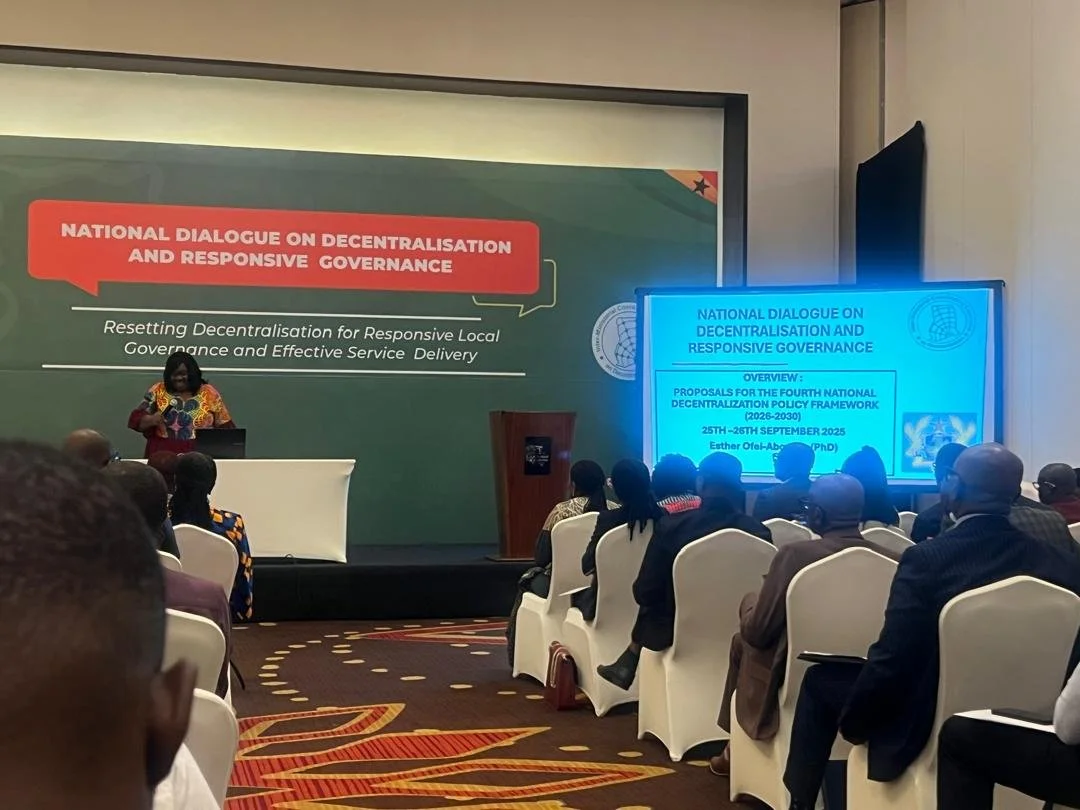Urban Heritage, Decentralization, and Responsible Local Governance
Jamestown: Tarquah house, Old Kingsway building, Usher Fort.
Photo by Paul Addo
Authored by Arc. David Kojo Derban
On 25th and 26th September, a two-day National Dialogue for Decentralization and Responsive Governance conference, organized by the Ministry of Local Government, Chieftaincy, and Religious Affairs, was held at the Kempinski Hotel in Accra.
The conference brought together government ministers, regional ministers, municipal and district chief executives, local governance experts, and prominent academics, administrators, and building environment professionals. I attended this conference with one main objective: to bring urban heritage to the attention of the government and to investigate how the management and care of historic urban areas and buildings could be incorporated into our local government system.
Ghana's numerous urban heritage sites, consisting of old historic state and private buildings, represent a vital component of our urban fabric. They play the role of being placeholders and memorials of our history and evolution as a people and a nation. Markers of our independence story, such as the Black Star monument, have significance not only for Ghana but for the continent of Africa, making them leading tourist attractions that add to the revenue streams of the country. Many other civic, religious, and educational buildings built in the colonial and independence periods throughout the nation also have historic significance and therefore hold the potential to attract tourists, as they do in other parts of the world. Urban heritage presents Ghana's unrealized tourism potential.
However, efforts towards their preservation are missing in political manifestos and rarely feature on the government's development agenda for cities and towns. Apart from the forts and castles, which are World Heritage sites, many state monuments and facilities have not yet been explored as key drivers in the tourism development drive. In recent years, a number of potential heritage buildings have been demolished, and the land sold to private investors. Others are at risk of being demolished to make way for planning new developments. Older ones are abandoned, as in the case of the iconic Africa Round Pavilion at the International Trade Fair in Accra. It was built in the sixties as our symbol of industrialization and international trade cooperation. For more than a decade, it has been neglected and left to deteriorate. Even though Ghana’s constitution, spatial planning, tourism, and museums and monuments laws recognize the importance of preserving tangible heritage, year after year, national development plans seem to ignore this aspect.
Under our local government system, Ghana is divided into 261 districts managed by metropolitan, municipal, and district assemblies (city authorities). This means that all these significant buildings of heritage belong to a district. Some districts, especially on the coast, hold more urban heritage assets than others in land. Cities like Accra, Tema, Elmina, Cape Coast, Takoradi, and Kumasi consist of several metropolitan municipal districts, which are blessed with rich historical resources, architectural landmarks, and neighborhoods, but many are in poor condition and rather add to the older derelict parts of the city with its associated social problems. Instead, under a renewed political will, these parts of the city could be transformed through conservation and restoration programs. Significant heritage structures could be legally recognized and listed as protected national monuments, managed, and promoted for tourism and education. Each district is represented in parliament by an elected MP, yet matters of appropriate legislation and institutional frameworks for urban heritage are not on the priority list of the government.
In comparison, there are a number of well-known urban heritage success stories throughout the world. Governments and policymakers worldwide are realizing that conserving urban history and funding conservation raises a city's profile internationally, yields impressive financial returns, and establishes long-term revenue streams for cities, regions, and countries. This has been recognized by the UNESCO Recommendation on the Historic Urban Landscapes (2011), which promotes an inclusive, holistic approach to heritage management that integrates conservation into urban development, rather than treating them separately. In great cities like Paris, Rome, London, Singapore, and many others, Urban heritage is an essential part of local government systems in places supported by international organizations such as UNESCO and the International Council of Monuments and Sites (ICOMOS). These systems enforce city bylaws and controls centered on cultural heritage, which prevent the historic parts of the cities from changes and allow them to remain as historical landmarks that are symbols of their identities and cultures and attract millions of tourists each year.
I was pleased to bring this important issue to the attention of key policymakers at the conference, proposing a review of the local government policy. Several stakeholders expressed a strong interest in further discussions about how heritage management could be integrated into our local government framework and align urban planning laws with conservation and regeneration. Most importantly, reviewing the local government policy and structure must address the inclusion of special urban conservation units consisting of architects, planners, urban designers, historians, conservators, and technicians within district assemblies. The presence of key architectural institutions at the conference, represented by the president of the Ghana Institute of Architects, the registrar of the Architects Registration Council, and the head of the Prestige (Public Works Department), underscored how important architects were to local government systems. Their professional skills would enhance the overall quality of our urban environment, preserving our cultural legacy of historic buildings for future generations.
Heritage preservation-oriented local governance has several advantages. Revitalization of historic neighborhoods will bring positive transformations to the old city's environmental aesthetics. New conservation area regulations will offer a new layer of enforcement targeted at improving sanitation and orderliness. This will undoubtedly boost the local economy, improve livelihoods, and create more hospitality businesses and recreation around urban heritage assets. Effectively managed, this should be possible if a dedicated portion of the District Assembly Common Fund per district or special funds arranged by the Ministry of Finance is allocated to preserve these state heritage assets and build the assembly's capacity for conservation work.
For Members of Parliament, municipal executives, and traditional chiefs who realize the importance of cultural heritage in district development, decentralizing urban heritage management and aligning heritage preservation with local governance creates a more responsive and economically viable approach to managing Ghana's rich architectural and cultural heritage and improving the city’s districts.

